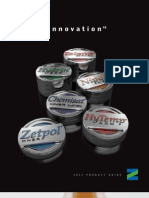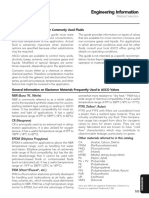Rado - Hydrogenated NBR Elastomer (HNBR), 2021 +
Rado - Hydrogenated NBR Elastomer (HNBR), 2021 +
Uploaded by
oreamigCopyright:
Available Formats
Rado - Hydrogenated NBR Elastomer (HNBR), 2021 +
Rado - Hydrogenated NBR Elastomer (HNBR), 2021 +
Uploaded by
oreamigOriginal Title
Copyright
Available Formats
Share this document
Did you find this document useful?
Is this content inappropriate?
Copyright:
Available Formats
Rado - Hydrogenated NBR Elastomer (HNBR), 2021 +
Rado - Hydrogenated NBR Elastomer (HNBR), 2021 +
Uploaded by
oreamigCopyright:
Available Formats
8/4/2021 Hydrogenated NBR elastomer (HNBR) | RADO Gummi GmbH
HNBR
HYDROGENATED NBR ELASTOMER
Hydrogenated NBR elastomer is formed by the selective hydrogenation of acrylonitrile-butadiene
rubber (NBR). In this process the double bonds are removed from the NBR, making the polymer
more resistant to oxygen and increasing its heat resistance signi cantly. In contrast to NBR,
hydrogenated NBR elastomer also o ers improved wear resistance in dynamic applications and
increased ageing resistance.
HNBR is resistant to hot water and steam and has good high- and low-temperature performance
with regard to its physical properties. In addition, these mixes also have high media and abrasion
resistance and good mechanical properties.
The oil resistance of hydrogenated NBR elastomer depends on the composition, in other words it is
determined largely by the ACN content.
In sealing technology, HNBR is used in particular in applications requiring good mechanical
strength and/or increased thermal stability. The strength of HNBR is of particular advantage in
piston and rod seals, but it is also bene cial for radial shaft seals, O-rings, diaphragms and bellows.
Furthermore, HNBR is a tried-and-tested material for seals, timing belts, hydraulic hoses and
AdBlue hoses and pump diaphragms in the automotive industry. Other important areas of
application can be found in oil and gas exploration, in the food industry and in the medical and
pharmaceutical sector.
https://www.rado-rubber.com/specialities/hnbr/#:~:text=Hydrogenated NBR elastomer is formed,increasing its heat resistance significantly. 1/4
8/4/2021 Hydrogenated NBR elastomer (HNBR) | RADO Gummi GmbH
CATALYTIC HYDROGENATION IMPROVES THE CHEMICAL AND THERMAL
RESISTANCE OF NBR
Hydrogenated NBR elastomer is produced from acrylonitrile-butadiene rubber, a copolymer of
acrylonitrile (ACN) and 1,3-butadiene. As the double bonds of the butadiene monomer units
remain in the NBR main chain, this material is susceptible to chemical in uences, thermal
degradation and oxidation. This disadvantage can be eliminated by means of catalytic
hydrogenation to form HNBR.
HYDROGENATION OF NBR
As well as the reaction conditions, the choice of catalyst is a critical factor for the hydrogenation
reaction. For the quantitative hydrogenation of NBR, the catalyst must have a su ciently high
activity and a high selectivity, so that only the ole nic double bonds, not the nitrile groups, are
hydrogenated. Heterogeneous palladium or homogeneous rhodium(I) catalysts are best suited to
NBR hydrogenation.
HETEROGENEOUSLY CATALYSED HYDROGENATION
On an industrial scale, the heterogeneous hydrogenation of acrylonitrile-butadiene rubber is
carried out using palladium as the active metal. Complete hydrogenation can be achieved with 0.01
to 1.0 weight percent palladium. If Group 1 to 6 metals, e.g. calcium, titanium, zirconium or
vanadium, are used as promotors, complete hydrogenation can also be achieved with a smaller
amount of palladium.
Transformation to HNBR usually takes place at a temperature of 50°C and under 50 bar hydrogen
pressure, in polymer solutions containing 10 weight percent rubber. The catalyst is then separated
o by ltration or centrifuging Once it has been separated o , it can in principle be reused,
although its activity will be reduced.
HOMOGENEOUSLY CATALYSED HYDROGENATION
Only Wilkinson's catalyst and RhH(PPh3)4 are used on an industrial scale for this type of NBR
hydrogenation. Both catalysts bring about a quantitative hydrogenation of the C=C double bonds,
without any reduction in nitrile groups.
https://www.rado-rubber.com/specialities/hnbr/#:~:text=Hydrogenated NBR elastomer is formed,increasing its heat resistance significantly. 2/4
8/4/2021 Hydrogenated NBR elastomer (HNBR) | RADO Gummi GmbH
The reaction is generally performed at temperatures from 100 to 150°C and under a pressure of 30
to 85 bar. In the lower pressure range, complete hydrogenation takes more than ten hours. The
reaction time can be reduced to a few hours by increasing the pressure. Once they have been
recovered, homogeneous catalysts are inactive and cannot be reused without being chemically
modi ed.
PROPERTIES OF HNBR
Unlike NBR, hydrogenated NBR elastomer has high heat and ageing resistance, which means that it
is frequently used both in sealing technology and also in dynamically challenging applications such
as synchronous belts. HNBR is also resistant to mineral oils, animal and vegetable oils and fats,
ame-resistant hydraulic uids (HFA, HFB and HFC) and some refrigerants. In long-term operation
(up to 1000 hours), fully hydrogenated HNBR grades can withstand temperatures of up to 150°C.
Partially hydrogenated HNBR can be crosslinked both with sulfur and accelerators and with
peroxides, whereas fully hydrogenated HNBR can only be crosslinked with peroxides.
Hydrogenated NBR elastomer – advantages at a glance:
Good media resistance/chemical resistance
High mechanical and dynamic strength
Suitable for use with hot water and steam
Ozone and weathering resistance
Good low-temperature exibility
Low compression set
High ageing resistance
Thermal stability from -40 to +150°C
The properties of HNBR, especially its oil resistance, are determined by the acrylonitrile content in
the vulcanisates. For good low-temperature performance, HNBR grades with a low ACN content
and speci c termonomers are recommended, whereas high-temperature resistance, a common
requirement in sealing technology, can be achieved by using highly saturated HNBR elastomers.
HYDROGENATED NBR ELASTOMER – POSSIBLE APPLICATIONS
In the automotive industry, HNBR is a well-established standard material for toothed belts, not
least because of its ageing resistance and dynamic load-bearing capacity. It is also recommended
as a starting material for many static and dynamic seals and hoses that come into contact with
engine and transmission oils and coolants. Hydrogenated NBR elastomer is also commonly used in
oil and gas exploration, since it has very good resistance to hydrogen sul de (H2S) and amine-
based stabilisers. In addition, HNBR is the best solution for dairies and other applications involving
contact with very fatty media in the food sector.
In sealing technology, hydrogenated NBR elastomer is primarily used where elevated temperatures
and/or high mechanical strength are required. HNBR o ers a broad spectrum of applications, in
both the process industry and the food industry. For example, hydrogenated NBR elastomer
is an
ideal sealing material for valve seats or in espresso machines.
https://www.rado-rubber.com/specialities/hnbr/#:~:text=Hydrogenated NBR elastomer is formed,increasing its heat resistance significantly. 3/4
8/4/2021 Hydrogenated NBR elastomer (HNBR) | RADO Gummi GmbH
CONTACT US
© 2021 RADO Gummi GmbH
Sitemap GTC Privacy Legal notice
https://www.rado-rubber.com/specialities/hnbr/#:~:text=Hydrogenated NBR elastomer is formed,increasing its heat resistance significantly. 4/4
You might also like
- Chemistry and Technology of Rubber PDFDocument215 pagesChemistry and Technology of Rubber PDFCharlie CB Portner100% (2)
- Hydrogenated Nitrile For Oilfield ApplicationsDocument6 pagesHydrogenated Nitrile For Oilfield ApplicationsHuỳnh TGNo ratings yet
- 03HNBR16Aug2012 PDFDocument4 pages03HNBR16Aug2012 PDFSid ShahNo ratings yet
- Hydrogenated NitrileDocument2 pagesHydrogenated Nitrileomar shadyNo ratings yet
- Rubber World HNBR Article - Therban AT PDFDocument9 pagesRubber World HNBR Article - Therban AT PDFAnusha Rajagopalan100% (1)
- Hydrogenated Nitrile Butadiene Rubber (HNBR) : Properties and ApplicationsDocument4 pagesHydrogenated Nitrile Butadiene Rubber (HNBR) : Properties and ApplicationsAjit SamalNo ratings yet
- Nitrile rubber-NBRDocument16 pagesNitrile rubber-NBRreilyshawnNo ratings yet
- General Rubber Compounds: By: Jim Ward, BRP ManufacturingDocument4 pagesGeneral Rubber Compounds: By: Jim Ward, BRP Manufacturing최승원No ratings yet
- Zeon Productguide 20150717Document16 pagesZeon Productguide 20150717khushboo.mamtani2932No ratings yet
- Acrylonitrile-Butadiene Rubber - NBRDocument7 pagesAcrylonitrile-Butadiene Rubber - NBRRubik Art100% (1)
- Ther MaxDocument65 pagesTher MaxAmeya SavnalNo ratings yet
- Oil-Resistant Rubbers: Machine DesignDocument5 pagesOil-Resistant Rubbers: Machine Designrajeevup2004No ratings yet
- Training Slides - Intro To Rubber TechnologyDocument48 pagesTraining Slides - Intro To Rubber Technologysimbua72No ratings yet
- A Cry Lo Nit RileDocument6 pagesA Cry Lo Nit RileSilvio CremmNo ratings yet
- Jiec-2013 7Document10 pagesJiec-2013 7militiamonNo ratings yet
- nbr002 1612 PDFDocument32 pagesnbr002 1612 PDFRanjith RNo ratings yet
- Asbestos Gaskets AdditivesDocument2 pagesAsbestos Gaskets Additivesm.naeem1974rajputNo ratings yet
- Product Guide 2012Document16 pagesProduct Guide 2012Daniele BoscoNo ratings yet
- Zetpol HNBR Rubber Elastomers - Zeon ChemicalsDocument17 pagesZetpol HNBR Rubber Elastomers - Zeon Chemicalscuenta_descarga88No ratings yet
- Arlanxeo NBR Product PortofolioDocument8 pagesArlanxeo NBR Product PortofolioErwin ErwinNo ratings yet
- B02 HNBRDocument8 pagesB02 HNBRSurendra RathoreNo ratings yet
- Practical Guide To HNBR Chapter 2Document8 pagesPractical Guide To HNBR Chapter 2Azizol WahabNo ratings yet
- Also Could Be Natural Milky White or Honey ColoredDocument2 pagesAlso Could Be Natural Milky White or Honey Coloredusebio64No ratings yet
- Raj Rubber ProductsDocument35 pagesRaj Rubber Productsnaveenraj mNo ratings yet
- Overview of ElastomersDocument2 pagesOverview of ElastomersRuilin TanNo ratings yet
- Butyl Rubber-IIRDocument26 pagesButyl Rubber-IIRreilyshawnNo ratings yet
- Nitrile Butadiene Rubber (NBR), Synthetic Latex: ApplicationDocument2 pagesNitrile Butadiene Rubber (NBR), Synthetic Latex: ApplicationbobNo ratings yet
- Defend 740Document2 pagesDefend 740Mohamed NouzerNo ratings yet
- Product DataDocument2 pagesProduct Datarangarajan1989No ratings yet
- Charactristcs of FKM and HNBR BlendsDocument9 pagesCharactristcs of FKM and HNBR Blendsadriano_rodsNo ratings yet
- Nitrile Rubber ApplicationsDocument2 pagesNitrile Rubber ApplicationsWs LimNo ratings yet
- Hempadur 15130Document2 pagesHempadur 15130MuthuKumarNo ratings yet
- Nitrile Rubber ApplicationsDocument6 pagesNitrile Rubber ApplicationsFelix CatNo ratings yet
- Hempadur Quattro 17634 TDSDocument4 pagesHempadur Quattro 17634 TDSNabeel K SNo ratings yet
- Aoisaioaioaoi JafDocument2 pagesAoisaioaioaoi JafJosephNo ratings yet
- Hempadur Quattro 17634: Product Characteristics Product SafetyDocument4 pagesHempadur Quattro 17634: Product Characteristics Product Safetyulul100% (1)
- LANXESS Butyl Rubber: A Global Supply For Growing IndustriesDocument11 pagesLANXESS Butyl Rubber: A Global Supply For Growing IndustriesLISONo ratings yet
- Module TCN1422 Term ReportDocument13 pagesModule TCN1422 Term ReporterickhadinataNo ratings yet
- Butyl & Chloroprene 2003Document16 pagesButyl & Chloroprene 2003Suyash TrivediNo ratings yet
- D. Compounding: o Ec o C S S S Oss e V I C S S S y A e SDocument3 pagesD. Compounding: o Ec o C S S S Oss e V I C S S S y A e SAnonymous Bpy4biucdQNo ratings yet
- Viton VS NBRDocument13 pagesViton VS NBRKathiravan PalanisamyNo ratings yet
- BAR SY 100 en FR Motultech 20210420Document2 pagesBAR SY 100 en FR Motultech 20210420Victor ZhicayNo ratings yet
- Rubber Lining For Phosphoric Acid PlantsDocument6 pagesRubber Lining For Phosphoric Acid PlantsAlexandros Giannikos100% (1)
- Butadiene-Styrene Rubber (SBR)Document35 pagesButadiene-Styrene Rubber (SBR)Alexander D.No ratings yet
- Choosing The Best Hose and Tube For Your Application: Chemical Compatibility GuideDocument43 pagesChoosing The Best Hose and Tube For Your Application: Chemical Compatibility GuideJuan AcuñaNo ratings yet
- 3.special Purpose Synthetic RubberDocument31 pages3.special Purpose Synthetic RubberbodekizNo ratings yet
- Hempel Shopprimer 15890ZSDocument2 pagesHempel Shopprimer 15890ZSAnuar SalehNo ratings yet
- Materiale GarnituriDocument3 pagesMateriale GarnituriFabius PopNo ratings yet
- Epdm Rubber Gasket HydrotechDocument3 pagesEpdm Rubber Gasket Hydrotechmusafir mufiNo ratings yet
- Mobil Rarus 800 Series FactsheetDocument2 pagesMobil Rarus 800 Series FactsheetSiswantoro Adi WibowoNo ratings yet
- Material Selection Guide: NBR Nitrile RubberDocument2 pagesMaterial Selection Guide: NBR Nitrile RubberNAMOGRENA DIAZNo ratings yet
- Rubber Linings OverviewDocument10 pagesRubber Linings OverviewhabibNo ratings yet
- Process Gas CompressorsDocument24 pagesProcess Gas CompressorsMSNo ratings yet
- Elastomers Properties PDFDocument5 pagesElastomers Properties PDFhadeNo ratings yet
- Rubber - Resin Materials - Rubber - Resin Materials - Technologies - NOK CORPORATIONDocument14 pagesRubber - Resin Materials - Rubber - Resin Materials - Technologies - NOK CORPORATIONvamsi patnalaNo ratings yet
- Hempadur Quattro InglesDocument3 pagesHempadur Quattro InglesElizabeth Maria Bazán MoralesNo ratings yet
- Paint Specification HamadourDocument2 pagesPaint Specification HamadourAbdul Majid LodhiNo ratings yet
- 2.synthetic Rubber TRG DR - JACOB K VARKEYDocument40 pages2.synthetic Rubber TRG DR - JACOB K VARKEYbodekizNo ratings yet
- Highly Efficient Methods for Sulfur Vulcanization Techniques, Results and Implications: Selection and Management of Rubber CurativesFrom EverandHighly Efficient Methods for Sulfur Vulcanization Techniques, Results and Implications: Selection and Management of Rubber CurativesNo ratings yet
- Loo - Effect of Swelling On Fatigue Life of Elastomers, 2015Document23 pagesLoo - Effect of Swelling On Fatigue Life of Elastomers, 2015oreamigNo ratings yet
- Hoffman - Solid State Phase Changes in Long Chain Compounds, 1953Document10 pagesHoffman - Solid State Phase Changes in Long Chain Compounds, 1953oreamigNo ratings yet
- 3 s2.0 B9780124095472124837 MainDocument18 pages3 s2.0 B9780124095472124837 MainoreamigNo ratings yet
- Universal Calibration of Gel Permeation Chromatography Using Evaporative Light Scattering Detector Coupled With ViscometerDocument10 pagesUniversal Calibration of Gel Permeation Chromatography Using Evaporative Light Scattering Detector Coupled With ViscometeroreamigNo ratings yet
- Bissada - Geochemical Inversion, 1992Document35 pagesBissada - Geochemical Inversion, 1992oreamigNo ratings yet
- US1892217Document9 pagesUS1892217oreamigNo ratings yet
- Boduszynski - Composition of Heavy Petroleums 2, 1988Document17 pagesBoduszynski - Composition of Heavy Petroleums 2, 1988oreamigNo ratings yet
- 1 s2.0 S2352340923009502 MainDocument11 pages1 s2.0 S2352340923009502 MainoreamigNo ratings yet
- Thomas - Transport Phenomena Through Polymeric Systems, 2001Document33 pagesThomas - Transport Phenomena Through Polymeric Systems, 2001oreamigNo ratings yet
- Tegelaar-A Reappraisal of Kerogen Formation, 1989Document4 pagesTegelaar-A Reappraisal of Kerogen Formation, 1989oreamigNo ratings yet
- Ey - The Influence of Carotenoid and Chlorophyll Content On The Oxidative Processes in Vegetable Oils, 2018Document8 pagesEy - The Influence of Carotenoid and Chlorophyll Content On The Oxidative Processes in Vegetable Oils, 2018oreamigNo ratings yet
- Tagelsir - Swelling and Tribological Properties of Melt-Mixed, FKM NBR, 2018Document18 pagesTagelsir - Swelling and Tribological Properties of Melt-Mixed, FKM NBR, 2018oreamigNo ratings yet
- Ganz 1987Document4 pagesGanz 1987oreamigNo ratings yet
- Mathai - Transport of Aromatic Through Crosslinked NBR, 1996Document27 pagesMathai - Transport of Aromatic Through Crosslinked NBR, 1996oreamigNo ratings yet
- Cong - Degradation of HNBR in Aqueous Solutions of H2S or HCL, 2013Document5 pagesCong - Degradation of HNBR in Aqueous Solutions of H2S or HCL, 2013oreamigNo ratings yet
- SPE-184188-MS Performance Analysis For Progressive Cavity Pump PCP Production Scenario in Sandy and Heavy Oil WellsDocument12 pagesSPE-184188-MS Performance Analysis For Progressive Cavity Pump PCP Production Scenario in Sandy and Heavy Oil WellsoreamigNo ratings yet
- Hayashi, Low Temperature Properties of HNBR, 1991Document11 pagesHayashi, Low Temperature Properties of HNBR, 1991oreamigNo ratings yet
- Prediction of Source Rock Characteristics Based On Terpane Biomarkers in Crude Oils: A Multivariate Statistical ApproachDocument13 pagesPrediction of Source Rock Characteristics Based On Terpane Biomarkers in Crude Oils: A Multivariate Statistical ApproachoreamigNo ratings yet
- I.: J. F. J.: Rheological Properties O F BitumensDocument17 pagesI.: J. F. J.: Rheological Properties O F BitumensoreamigNo ratings yet
- Mass For Of: Scale Based On Resolution Mass Spectrometry Organic CompoundsDocument9 pagesMass For Of: Scale Based On Resolution Mass Spectrometry Organic CompoundsoreamigNo ratings yet
- Optical Density Measurement For Petroleum Oils: ColorDocument7 pagesOptical Density Measurement For Petroleum Oils: ColororeamigNo ratings yet
- Nwachukwu 1985Document8 pagesNwachukwu 1985oreamigNo ratings yet
- Oil ViscocityDocument11 pagesOil ViscocityLouie Dupaya100% (1)
- 2015 - Ferreira - Fiber-Matrix Bond FNL-cement - ArtigoDocument11 pages2015 - Ferreira - Fiber-Matrix Bond FNL-cement - ArtigoJeferson Pereira SilvaNo ratings yet
- Moduflex FRL TechnicalDocument56 pagesModuflex FRL Technicalking4lifeNo ratings yet
- Hoses StaubliDocument36 pagesHoses StaubliLucas Gonçalves AlbinoNo ratings yet
- H WatermarkedDocument36 pagesH WatermarkedMaintenanceNo ratings yet
- 3CP1221-1241 SchematicDocument4 pages3CP1221-1241 Schematicab5951No ratings yet
- Aakash AIEEE 2009 SolutionsDocument36 pagesAakash AIEEE 2009 SolutionsSayan Das KarmakarNo ratings yet
- Material-Technology (EP. EPR & EPDM)Document2 pagesMaterial-Technology (EP. EPR & EPDM)Federico MoranNo ratings yet
- Powell Hydraulic Hose Catalogue Price List 2017Document20 pagesPowell Hydraulic Hose Catalogue Price List 2017Anonymous VRspXsmNo ratings yet
- Rubber Expansion JointsDocument32 pagesRubber Expansion JointssailbirdNo ratings yet
- Rolamentos Vedados SKFDocument28 pagesRolamentos Vedados SKFJose GomesNo ratings yet
- Safety Data Sheet: 1 Identification of The Substance/preparation and of The Company/undertakingDocument8 pagesSafety Data Sheet: 1 Identification of The Substance/preparation and of The Company/undertakingRiaNo ratings yet
- Catalog G-1 Chem, Lubricants and AccDocument32 pagesCatalog G-1 Chem, Lubricants and AccBrayan MejiaNo ratings yet
- Three Types of Rubber Molding - How To Make Rubber Molded PartsDocument19 pagesThree Types of Rubber Molding - How To Make Rubber Molded Partsabd elmohsen saed100% (1)
- Arlanxeo HNBR Therban enDocument7 pagesArlanxeo HNBR Therban enM J VoraNo ratings yet
- Shelf Life ISO 2230 2002Document1 pageShelf Life ISO 2230 2002Pahe DriveNo ratings yet
- Aerospace T-Seals: ISO 9001 CertifiedDocument20 pagesAerospace T-Seals: ISO 9001 Certifiedchamaljs100% (1)
- Sist en Iso 472 2014Document15 pagesSist en Iso 472 2014امین ادیب نیاNo ratings yet
- Viton VS NBRDocument13 pagesViton VS NBRKathiravan PalanisamyNo ratings yet
- AVK Resilient Seated Gate ValvesDocument36 pagesAVK Resilient Seated Gate ValvesCarel De JagerNo ratings yet
- Apex Conveyor Handbook 2002Document92 pagesApex Conveyor Handbook 2002linmar7071No ratings yet
- EZR Installation ManualDocument40 pagesEZR Installation ManualRoberto Aldayuz HerediaNo ratings yet
- Catalog Varvel RS RTDocument60 pagesCatalog Varvel RS RTNikola VojisavljevicNo ratings yet
- Rubber TechnologyDocument28 pagesRubber Technologyluis martinez100% (2)
- Hole Quality and Burr Reduction in Drilling Aluminium SheetsDocument6 pagesHole Quality and Burr Reduction in Drilling Aluminium SheetsBharathkumar.sekarNo ratings yet
- Chemical Resistanace Chart 20171Document19 pagesChemical Resistanace Chart 20171dyaza_1No ratings yet
- ASCO Engineering Guide 061108Document34 pagesASCO Engineering Guide 061108Karuna gantiNo ratings yet
- Vacuum Relief Valve: Product Literature & Maintenance GuidelinesDocument17 pagesVacuum Relief Valve: Product Literature & Maintenance GuidelinesRaghavan VenkatramanNo ratings yet
- Lab Report 1Document4 pagesLab Report 1faiquaNo ratings yet














































































































